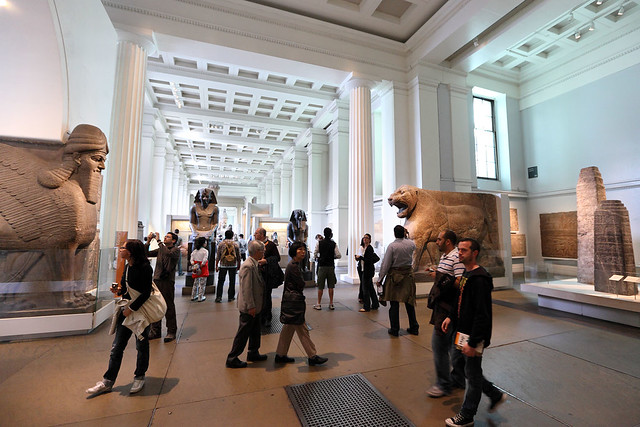
Assyrian Gallery, The British Museum
[ < < previous | index | next >> ]
It's late because I was actually just finishing off yesterday's diary entry. We got up late today after a snooze-in to well past 09:00. This on top of a good uninterrupted sleep recharged us for the day. And what a day it was!
We began with breakfast at Pret a Manger, a block down Euston Road. We both had a yoghurt-muesli-fruit compote mix, and I had an almond croissant while M. had a seed and nut bar. (A "bird bar".) We tried the allegedly free wi-fi again, and this time managed to get it working by simply signing in with a name and e-mail address, without any sort of account. M. retrieved e-mail and sent a message to her mum.
Done eating, we hopped a bus the few stops down Woburn Place to the British Museum. We could have walked, but M. had developed a blister on her little toe and we wanted to minimise the walking a bit.
 Assyrian Gallery, The British Museum |
The British Museum, whoa! The plan is to see some of its vast collection of antiquities today, and then spend all day on Monday there as well to give us a half-decent chance of seeing most of the really good stuff. And when we arrived and got a map of the museum, we realised we might need a third visit. But thankfully it is completely free to visit the museum. And, as I quickly discovered, they allow photography of every single thing you can see inside, even so far as with flash (but not tripods). Here is perhaps the greatest collection of human historical artefacts in the entire world, and it's open to everyone for no charge.
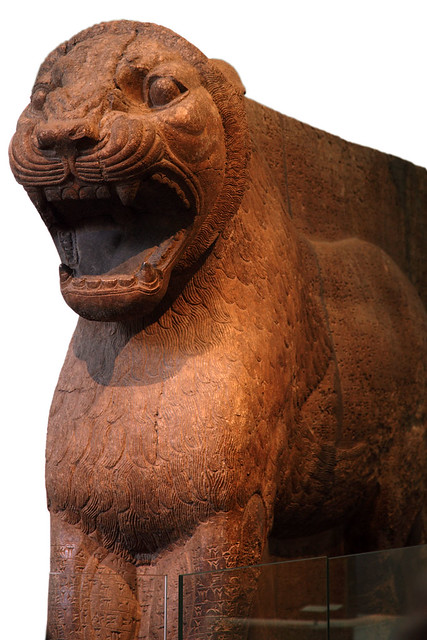 Assyrian Lion, British Museum |
And what's more, we soon discovered that many of the amazing items on display are not behind glass. We were quickly lured into the rooms near the entry containing Assyrian and Ancient Egyptian monumental sculpture. Most of the pieces were displayed on the floor or pedestals, with no security barrier. You could, if you desired, simply reach out and touch them. Signs requested that you didn't, because the stone would wear and discolour, but there was nothing physical to stop you getting as close as you wanted to see the intricacies of the carving in detail. And there weren't guards everywhere either, warning people not to touch stuff. People, including children, simply kept a suitable distance out of sheer awe and respect for what they were seeing. It was absolutely brilliant.
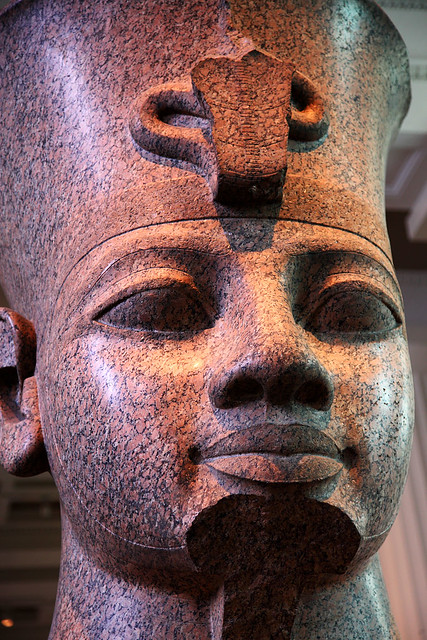 Egyptian Gallery, British Museum |
And I haven't even gotten on to describing the items yet! The Assyrian stuff was astonishing. There were astoundingly detailed and beautiful relief sculptures of lion hunting and other activities, which lined the walls of gallery after gallery. There were huge monumental lion figures flanking an ancient city gate. There was heaps of other stuff I would need a reference book of the museum collection to recall accurately - there was just so much amazing stuff to take in.
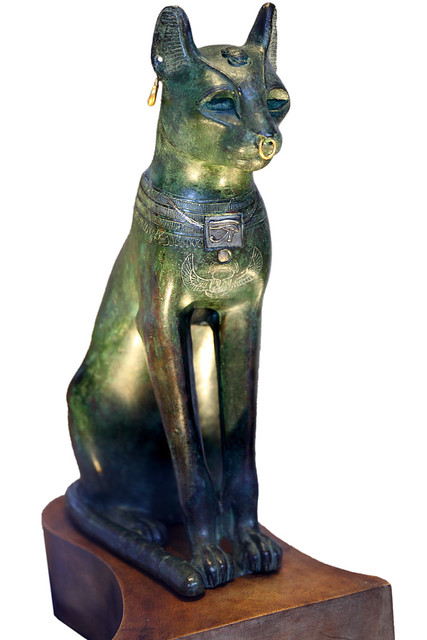 The Gayer-Anderson Cat, British Museum |
And then, there were the Egyptian galleries. Oh my. There were giant sculptures, stelae, obelisks, columns, and so on, of black granite, pink granite, basalt, limestone. There was a stunning life sized bronze cat with gold jewellery - the Gayer-Anderson Cat. There were giant heads, sphinxes, animal-headed gods, enormous carved arms and feet of statues now mostly lost. In the middle of all this, in one of the very few sealed cases, so it was actually physically impossible to touch it, was the Rosetta Stone.
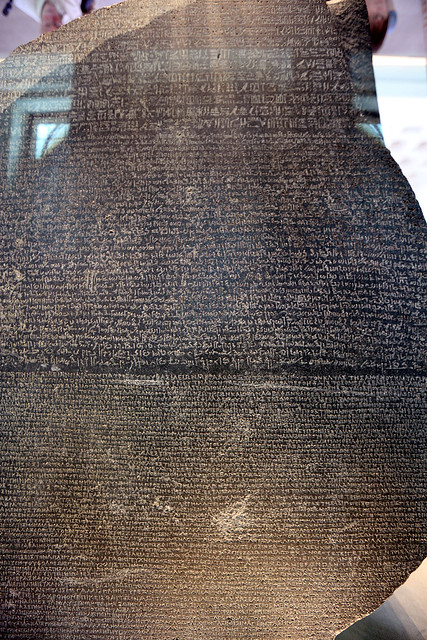 The Rosetta Stone, British Museum |
Possibly the most famous and significant single lump of rock in human history. Right there! In front of us! This was the stone that Jean-François Champollion had laboured over in the early 1800s to decipher for the first time in over 1500 years the ancient Egyptian hieroglyphs - this was the key to learning what thousands upon thousands of monuments, sculptures, carvings, paintings, and papyruses from that era of history actually say - this stone gave us 4000 years of recorded human history. And it was sitting there, free for anyone who happens to be in London to come and see. The sheer enormity of what it meant weighed heavily on us as we circled the stone reverently, savouring the appearance of the etched characters on its face in the three scripts: Hieroglyphic, Demotic, and Ancient Greek. The black basalt both absorbed and radiated a feeling of time and space, of human drama and existence across thousands of years. It was really very, very cool.
From there, we went on to galleries of Greek and Roman sculpture, with many impressive examples of classical marble statuary. Then it was a short walk to the museum's most controversial collection: the Elgin Marbles. Transported from the Parthenon in Athens in 1801, with the approval of the then-occupying Ottoman rulers, Athens has wanted them back ever since the Greeks regained power.
 Elgin Marbles, British Museum |
The long rows of marble relief carvings that once adorned the Temple of Athena were incredible, with beautifully carved figures of men, women, centaurs, horses, bulls, and other animals popping out of the surface with fully formed three-dimensional bodies, many draped in intricate folds of clothing. There were detailed plaques describing each group of figures and a separate audio guide was available just for this one gallery, to take you through the entire Elgin collection in detail. There was also a large ante-room with full-sized reproductions of a subset of the carvings for people to touch - designed for visually impaired visitors. (In fact, earlier in the Egyptian rooms the signs warning against touching the statues stated that only visually impaired people on guided "touch tours" were allowed to touch them. Pretty cool.)
From here we toured through more Assyrian sculpture, ticking off the galleries we'd visited so we could attack them systematically. By now it was about 14:00 and we were getting hungry after our late breakfast. We left the museum and took a 521 bus to London Bridge, and across the Thames, where the Borough Market promised a feast of food.
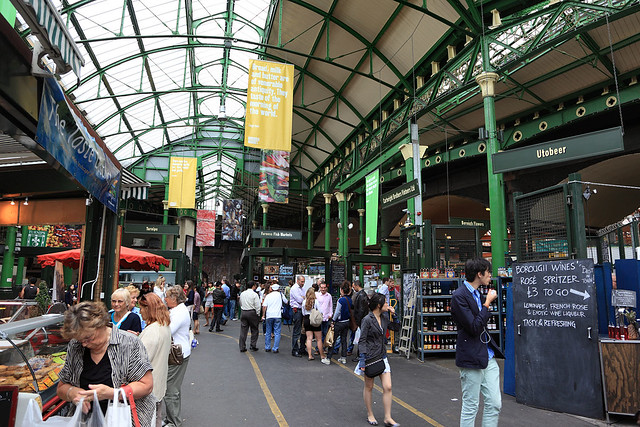 Borough Market |
The market did not disappoint. It was packed with food stalls, both fresh and cooked for immediate consumption. The first thing we saw on entering was the World's Largest Paella, being cooked on an enormous round pan, circled by hundreds of giant prawns and with a mound of rice about half a metre high in the middle. Further in, we saw not one but two of the World's Biggest Thai Green Curries - one chicken and one seafood - in similar sized pans, emitting their enticing aroma for several stalls around.
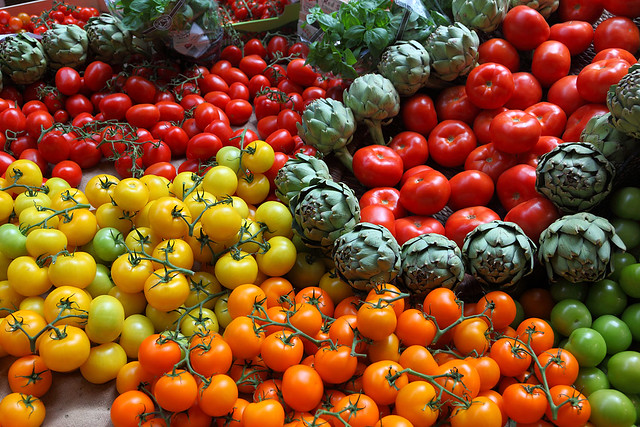 Tomatoes and artichokes, Borough Market |
There were: fresh fruit and vegetable stalls laden with colourful produce; lots of cheese sellers, some selling only one type of cheese, with big wheels of it stacked on the tables, others offering a wide selection; bakers with dozens of differently styled loaves and rolls; other bakers with cakes, biscuits, and/or muffins of various descriptions; olive sellers; nut vendors; chocolate sellers; purveyors of other types of sweets; one store consisting of dozens of flavours of Turkish delight; then there were butchers, fishmongers, pie makers, purveyors of sausages and cured meats, wine sellers, coffee bean stalls, fruit juice stalls, fish and chip shops, and many more.
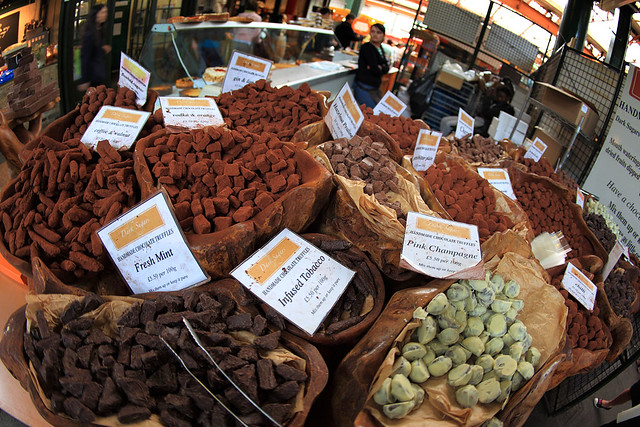 Chocolate truffles, Borough Market |
One stall was making hot cheese sandwiches and raclettes - a plate of potatoes, pickled onions and gherkins, smothered in melted cheese. They were melting the cheese by cutting a small wheel in half, then holding it cut side up in a bracket under a hot element so the cheese all along the cut surface melted and bubbled away. Then the half-wheel was removed and all the melted surface scraped away on to the potatoes with a knife before being put back to melt the next layer of cheese. They had four semi-circles of cheese going at a time to melt it fast enough to keep up with orders. I got one of these tempting cheesy treats, while M. opted for the cheese toasty. They were both very good, but very expensive, at £4 for the toast and £5 for the raclette. Lucky we're on holiday and not thinking about the budget!
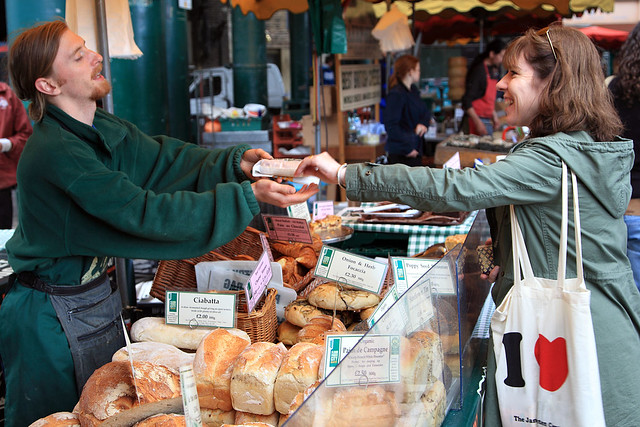 Buying bread, Borough Market |
Since these were not enough to fill the entire lunch quota, we sought further goodies. M. got a spinach and ricotta roll, while I went for a fried bratwurst on a bun with mustard and sauerkraut, followed by a tempting slice of carrot cake. Thus stuffed to the gills, we headed out of the market and back to the British Museum for another assault on its collection.
Back at the museum, we asked about which galleries would be remaining open late. The museum normally closes at 17:30, but on Thursdays and Fridays selected galleries stay open until 20:30. Armed with this knowledge, we knocked off the remaining Assyrian rooms and some rooms of Greek vases and sculpture just before they closed. We were the last people ushered out of one of the rooms which was then blocked for the evening.
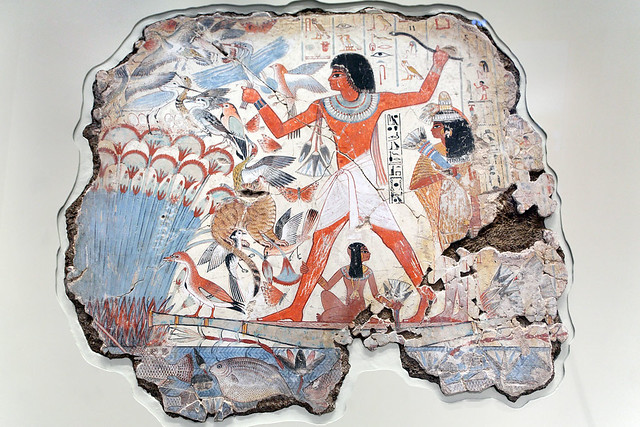 Egyptian fresco, British Museum |
We proceeded upstairs to the remaining Ancient Egyptian galleries, these ones dealing with life and death and containing small artefacts as opposed to the monumental sculpture downstairs. In particular, there were several mummies with sarcophagi decorated inside and out in various styles making the progression of artistic style across the Egyptian dynasties. There were also mummified animals: several cats, a couple of falcons, fish, two crocodiles, and an ibis.
 Mummified cats, British Museum |
Accompanying the mummies and coffins were ushabtis representing servants for the deceased in the afterlife, canopic jars - several sets of four, each topped with the required set of sculptures of a falcon, baboon, jackal, and man - for holding the internal organs separated into four pieces, and fragments of papyrus copies of the Book of the Dead, containing the spells and rituals necessary to ensure safe passage to the afterlife. There were examples of all these from Early, Middle, and Late dynasties, the Greek-influenced Ptolemaic periods, and the succeeding Roman era. Some of the stelae were actually inscribed in Greek letters rather than hieroglyphs. Wrapping up the mummies, we moved on to even older stuff, with pre-dynastic artefacts such as wooden and stone farming tools. There were also daily life objects such as sleeping head-rests, cosmetics containers (two of them shaped like ducks), combs, jewellery, and so on.
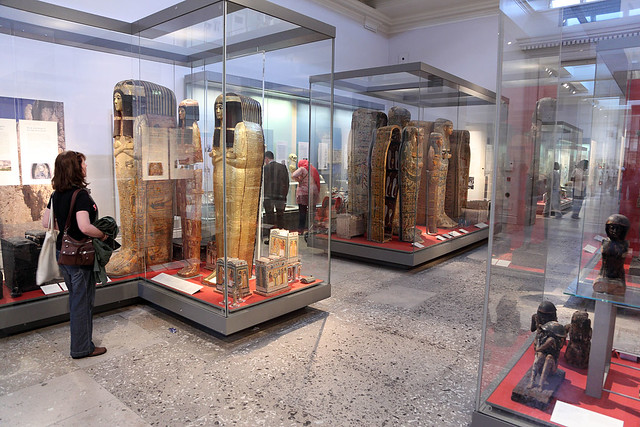 Mummy room, British Museum |
By now it was getting late and we still needed dinner. We headed back to our hotel on the bus and dropped our bags off before heading to a pub we found down a nearby side street. I was going to order bangers and mash, but they were out of mash! So I tried a lemon chicken and rice dish, which came with peas and salad. M. tried the vegetable burger, which was a pattie made of recognisable vegetables rather than the lentil/tofu thing at Mabel's Tavern, but was declared good. M. had an apple juice and I had to cider to wash it all down. Following this rather late dinner we simply headed back to our room and crashed for the night.
[ < < previous | index | next >> ]